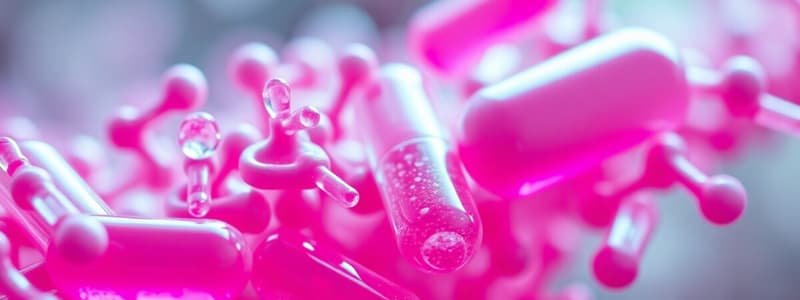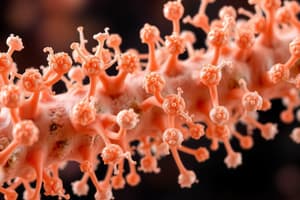Podcast
Questions and Answers
Which mode of action involves blocking the synthesis of a fundamental component of bacterial cell walls?
Which mode of action involves blocking the synthesis of a fundamental component of bacterial cell walls?
- Inhibition of Protein Synthesis
- Inhibition of Cell Wall Synthesis (correct)
- Inhibition of Nucleic Acid Synthesis
- Injury to Plasma Membrane
What is the primary target of amphotericin B in fungal cells?
What is the primary target of amphotericin B in fungal cells?
- Cellulose
- Ergosterol (correct)
- Cholesterol
- Peptidoglycan
Which example is associated with disrupting bacterial ribosomes to inhibit protein synthesis?
Which example is associated with disrupting bacterial ribosomes to inhibit protein synthesis?
- Ciprofloxacin
- Tetracycline (correct)
- Polymyxin B
- Sulfonamides
What is a unique characteristic of sulfonamides compared to human metabolic pathways?
What is a unique characteristic of sulfonamides compared to human metabolic pathways?
What type of antibiotic action leads to increased permeability of the bacterial membrane?
What type of antibiotic action leads to increased permeability of the bacterial membrane?
Which antibiotic specifically targets DNA gyrase in bacteria?
Which antibiotic specifically targets DNA gyrase in bacteria?
What challenge is commonly faced when treating fungal infections?
What challenge is commonly faced when treating fungal infections?
Which antibiotic mechanism of action is NOT specific to bacterial cells?
Which antibiotic mechanism of action is NOT specific to bacterial cells?
What is the primary mechanism by which acyclovir acts against herpes viruses?
What is the primary mechanism by which acyclovir acts against herpes viruses?
Which feature of penicillin is crucial for its antibacterial effectiveness?
Which feature of penicillin is crucial for its antibacterial effectiveness?
Why are natural penicillins like Penicillin G typically more susceptible to penicillinase?
Why are natural penicillins like Penicillin G typically more susceptible to penicillinase?
What characteristic of Mycobacterium tuberculosis contributes to its antibiotic resistance?
What characteristic of Mycobacterium tuberculosis contributes to its antibiotic resistance?
Which antibiotic works by specifically inhibiting the synthesis of mycolic acids?
Which antibiotic works by specifically inhibiting the synthesis of mycolic acids?
In the Disk-Diffusion Test (Kirby-Bauer Test), what does a larger zone of inhibition indicate?
In the Disk-Diffusion Test (Kirby-Bauer Test), what does a larger zone of inhibition indicate?
Where is beta-lactamase produced, and what is its function?
Where is beta-lactamase produced, and what is its function?
What distinguishes synthetic penicillin from natural penicillin?
What distinguishes synthetic penicillin from natural penicillin?
What distinguishes bactericidal antibiotics from bacteriostatic antibiotics?
What distinguishes bactericidal antibiotics from bacteriostatic antibiotics?
What type of toxin is specifically secreted by bacteria and has potent effects?
What type of toxin is specifically secreted by bacteria and has potent effects?
Which process describes how immune responses can cause damage to host cells during an infection?
Which process describes how immune responses can cause damage to host cells during an infection?
How do siderophores contribute to microbial virulence?
How do siderophores contribute to microbial virulence?
Which statement accurately summarizes the difference between exotoxins and endotoxins?
Which statement accurately summarizes the difference between exotoxins and endotoxins?
What mechanism of damage do viruses use to harm host cells?
What mechanism of damage do viruses use to harm host cells?
What best describes the concept of selective toxicity in antimicrobial drugs?
What best describes the concept of selective toxicity in antimicrobial drugs?
Which of the following is a characteristic of endotoxins?
Which of the following is a characteristic of endotoxins?
What determines the minimum inhibitory concentration (MIC) in the E-test?
What determines the minimum inhibitory concentration (MIC) in the E-test?
How do two antibiotics working together to enhance effectiveness illustrate the concept of synergism?
How do two antibiotics working together to enhance effectiveness illustrate the concept of synergism?
Which of the following accurately describes antagonism in the context of antibiotic interaction?
Which of the following accurately describes antagonism in the context of antibiotic interaction?
Which process involves bacteria taking up free DNA from their environment to obtain resistance genes?
Which process involves bacteria taking up free DNA from their environment to obtain resistance genes?
What mechanism involves bacteria modifying their membranes to prevent antibiotic entry?
What mechanism involves bacteria modifying their membranes to prevent antibiotic entry?
Which term refers to the ability of bacteria to survive antibiotic treatment due to genetic changes?
Which term refers to the ability of bacteria to survive antibiotic treatment due to genetic changes?
What is the term for the concentration of an antibiotic that kills bacteria?
What is the term for the concentration of an antibiotic that kills bacteria?
Which of the following mechanisms is NOT a common method by which bacteria acquire antibiotic resistance genes?
Which of the following mechanisms is NOT a common method by which bacteria acquire antibiotic resistance genes?
Which of the following best describes the primary action of antibiotics?
Which of the following best describes the primary action of antibiotics?
What is a broad-spectrum antibiotic?
What is a broad-spectrum antibiotic?
Why are antifungal treatments more challenging compared to antibacterial treatments?
Why are antifungal treatments more challenging compared to antibacterial treatments?
What is a superinfection?
What is a superinfection?
Which of the following characteristics is true regarding MRSA?
Which of the following characteristics is true regarding MRSA?
What does the term 'spectrum of activity' refer to in antimicrobial drugs?
What does the term 'spectrum of activity' refer to in antimicrobial drugs?
What is one reason why antibiotic misuse leads to resistance?
What is one reason why antibiotic misuse leads to resistance?
What distinguishes antibacterial drugs from other types of antimicrobial agents?
What distinguishes antibacterial drugs from other types of antimicrobial agents?
Flashcards are hidden until you start studying
Study Notes
Antimicrobial Drugs & Chemotherapy
- Antimicrobial drugs kill or inhibit microorganism growth (bacteria, fungi, viruses, protozoa).
- Antibiotics are naturally produced antimicrobial drugs (e.g., penicillin).
- Bactericidal antibiotics kill bacteria (e.g., penicillin), while bacteriostatic ones inhibit growth (e.g., tetracycline).
- Selective toxicity targets microbes without harming host cells.
Microbial Damage Mechanisms
- Direct Damage: Microbes invade and destroy host cells (e.g., viruses).
- Toxin Production: Bacteria release toxins damaging host tissues. Siderophores scavenge iron. Exotoxins are secreted proteins with specific effects; endotoxins (lipopolysaccharides or LPS) are part of Gram-negative bacterial cell walls, released upon cell death causing inflammation. Exotoxins are generally more potent and targeted than endotoxins.
- Immune Response: The immune system's response can cause collateral tissue damage.
- Viruses invade host cells, replicate, and lyse the cells, spreading infection.
Antibiotics and Antimicrobial Drugs
- Antibiotics are substances produced by microbes to kill or inhibit other microbes. Streptomyces bacteria and Penicillium fungi are common sources.
- Antimicrobial drugs encompass antibiotics and synthetic/semisynthetic drugs.
- Antibiotics target bacterial structures (cell walls, 70S ribosomes) absent in human cells (80S ribosomes).
Chemotherapy Challenges
- Bacterial infections: Antibiotic resistance (e.g., MRSA).
- Viral infections: Antiviral drugs have limited effectiveness due to viral reliance on host cell machinery.
- Fungal infections: Fungal cells' similarity to human cells complicates treatment.
Key Chemotherapy Terms
- Spectrum of activity: Range of microbes targeted by a drug. Broad-spectrum antibiotics target Gram-positive and Gram-negative bacteria (e.g., tetracycline).
- Superinfection: Secondary infection due to normal flora disruption by antibiotics.
- Understanding a drug's mechanism is crucial for effective use and resistance prevention.
- MRSA (Methicillin-Resistant Staphylococcus aureus) is resistant to many antibiotics.
Antimicrobial Drug Groups and Modes of Action
- Three groups: antibacterial, antiviral, antifungal.
- Five modes of antibiotic action:
- Inhibition of cell wall synthesis (e.g., penicillin).
- Inhibition of protein synthesis (e.g., tetracycline).
- Inhibition of nucleic acid synthesis (e.g., ciprofloxacin).
- Injury to the plasma membrane (e.g., polymyxin B).
- Inhibition of metabolic pathways (e.g., sulfonamides).
Antifungal Antibiotics
- Many target the fungal cell membrane component ergosterol (e.g., amphotericin B).
- Challenges: Fungi's eukaryotic nature complicates treatment, leading to side effects.
Antiviral Drugs & Penicillin
- Antiviral drugs interfere with viral replication (e.g., acyclovir for herpes viruses).
- Penicillin's beta-lactam ring inhibits bacterial cell wall synthesis by blocking transpeptidase.
- Natural penicillin (e.g., penicillin G) has a limited spectrum. Synthetic penicillin (e.g., amoxicillin, methicillin) has broader spectrums or resistance to degradation.
- Penicillinase (beta-lactamase) breaks the beta-lactam ring.
Mycobacterial Resistance
- Mycobacteria (e.g., Mycobacterium tuberculosis) have waxy cell walls (mycolic acids) and slow growth, contributing to resistance.
- Isoniazid inhibits mycolic acid synthesis.
Antibiotic Sensitivity Tests
- Disk-diffusion (Kirby-Bauer) test: measures zone of inhibition around antibiotic disks.
- E-test: determines minimum inhibitory concentration (MIC) using a gradient strip.
- Broth-dilution test: determines MIC and minimum bactericidal concentration (MBC).
Synergism, Antagonism, and Resistance
- Synergism: combined effect of antibiotics is greater than the sum of individual effects.
- Antagonism: one antibiotic reduces another's effectiveness.
- Antibiotic resistance: bacteria survive antibiotic exposure.
- Horizontal gene transfer (transformation, conjugation, transduction) spreads resistance genes.
Bacterial Resistance Mechanisms
- Enzymatic destruction of antibiotics.
- Altered antibiotic targets.
- Efflux pumps remove antibiotics.
- Reduced permeability to antibiotics.
Studying That Suits You
Use AI to generate personalized quizzes and flashcards to suit your learning preferences.





